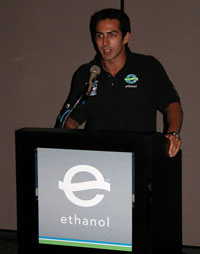 2006 may someday be known as the year our nation made a Declaration of Energy Indepedence.
2006 may someday be known as the year our nation made a Declaration of Energy Indepedence.
When we declared our independence 230 years ago, there were many difficulties and hardships for the people of the new nation to face – not the least of which was a war. By cutting ourselves off from England we had to become more self-sufficient, and in many cases that involved sacrifice.
People complain about ethanol being less fuel efficient than gasoline, that it uses too much fertilizer or natural gas or water to make, that there’s not enough or it’s too expensive right now. But, it is made in America. The fossil fuels that we have been dependent on as a nation to fuel our vehicles are NOT. That is the real reason we are trying to make this happen and it won’t happen overnight. Our independence as a country did not happen overnight. It required effort, sacrifice, ingenuity, and the courage to make a change, even if it costs more.
Is ethanol the one and only answer to our energy independence? Absolutely not. Can we improve upon its shortcomings in terms of fuel efficiency, production and availability? Absolutely. Good old American know-how can make it happen. Cellulosic ethanol can address many of the issues and it is not too far down the road. And let’s not forget the other alternatives like biodiesel, biobutanol, hydrogen, etc. AND, we do need to learn how to conserve fuel by using less of it.
Domestic Fuel made in America is helping us on the road to energy independent as a nation. We grow our own food, we can grow our own fuel also. God bless America.


 Have a very happy 4th of July celebration wherever you are.
Have a very happy 4th of July celebration wherever you are.

 They indicated that through additional production of these vehicles, the country can help secure energy independence. They also indicated that the increase in production of FFVs can not do this job alone; the government must assist in allowing incentives for alternative fuel infrastructure and the price of E85 must be competitive to gasoline.
They indicated that through additional production of these vehicles, the country can help secure energy independence. They also indicated that the increase in production of FFVs can not do this job alone; the government must assist in allowing incentives for alternative fuel infrastructure and the price of E85 must be competitive to gasoline.  Team Ethanol had an honorary pit crew member this weekend in Kansas City. It was a dream come true for 21-year-old Casey Brickey, who suffers from a progressive form of muscular dystrophy. Last year Brickey teamed up with the ethanol industry to raise money for the
Team Ethanol had an honorary pit crew member this weekend in Kansas City. It was a dream come true for 21-year-old Casey Brickey, who suffers from a progressive form of muscular dystrophy. Last year Brickey teamed up with the ethanol industry to raise money for the  Willie Nelson is celebrating our nation’s energy independence this week in Carl’s Corner, Texas with opening of his joint venture production plant,
Willie Nelson is celebrating our nation’s energy independence this week in Carl’s Corner, Texas with opening of his joint venture production plant,  It was a hot one at the Kansas Speedway today for the Kansas Lottery Indy 300. Jeff Simmons had a great day, finishing 10th after starting out in the number 17 position.
It was a hot one at the Kansas Speedway today for the Kansas Lottery Indy 300. Jeff Simmons had a great day, finishing 10th after starting out in the number 17 position. I have to say that when you hear an Indy car cranking it up on the track it does get your pulse racing along with it.
I have to say that when you hear an Indy car cranking it up on the track it does get your pulse racing along with it.
 Out at Kansas Speedway early on a Performance Weekend Saturday I found the ethanol symbol everywhere you look.
Out at Kansas Speedway early on a Performance Weekend Saturday I found the ethanol symbol everywhere you look.  After leaving Washington, DC and the convoy I’ve been travelling with for the last 2 weeks it was on to Kansas City for the Ethanol Promotion and Information Council’s “Performance Weekend.” This is a weekend of activities for EPIC members that includes Sunday’s
After leaving Washington, DC and the convoy I’ve been travelling with for the last 2 weeks it was on to Kansas City for the Ethanol Promotion and Information Council’s “Performance Weekend.” This is a weekend of activities for EPIC members that includes Sunday’s  Also on hand was Rahal-Letterman team driver, Jeff Simmons. Jeff will be driving the #17 Ethanol Car in tomorrow’s race.
Also on hand was Rahal-Letterman team driver, Jeff Simmons. Jeff will be driving the #17 Ethanol Car in tomorrow’s race.
 At the end of the cross country convoy adventure, we had one last press conference as our closing ceremony for the historic trip.
At the end of the cross country convoy adventure, we had one last press conference as our closing ceremony for the historic trip. She is Mary Eisenhower, granddaughter to President Eisenhower. Like her son Merrill, who travelled with us, she is very well spoken.
She is Mary Eisenhower, granddaughter to President Eisenhower. Like her son Merrill, who travelled with us, she is very well spoken.